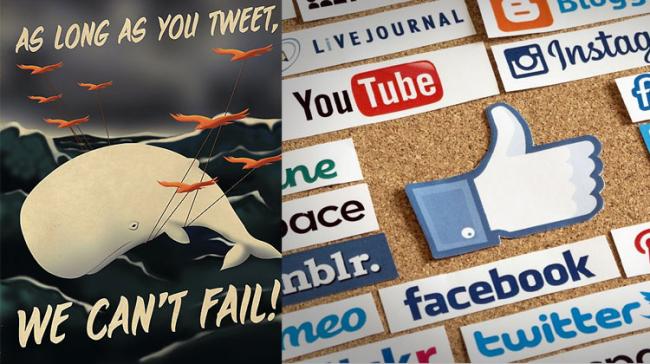Social Media And Optics In Politics

Y. Satyanarayana
Politics is a lot about perception. The new theatre of political face-offs, contests and one-upmanship is the social media. If one were to follow the fast and furious campaigns being waged on Twitter and Facebook both by the BJP and Congress, one would understand the relevance of optics. The age of political wars on social media is well and truly upon us. However, it will take a long time for it to trickle down to rural India, often aptly referrred to as "the real India."
Just one example which mirrors this great divide between the real India and the India which is powered by a social media narrative, would do. Take the case of Sharad Pawar. Despite being the butt of TV comedians and others as being allegedly the richest politician in the country, Pawar has been one of the most powerful figures in national politics. The 77 year-old president of the Nationalist Congress Party from Baramati continues to be a force to reckon with, wooed by all political parties on the national stage. Can all the lampooning on Twitter and Facebook influence voters in his constituency? You could apply this logic to Owaisi, Giriraj Singh, Lalloo, Azam Khan and a host of other leaders.
Yes, winds of change are blowing, but we haven't yet reached a point where the social media narrative can dominate public course. A tweet from Donald Trump might make the US gasp, but it will take us many years to get there.
The 2014 Lok Sabha elections saw a high octane campaign driven by the BJP, which had a huge impact on the urban middle-class. The fact that what once used to be smaller towns across the country are now emerging metropolises with tech savvy youth, equipped with smart phones, tablets and laptops drove the campaign on the internet, and in the end, the BJP, simply outgunned everybody else in the fray. The Congress was left completely clueless, but to be fair, so was everyone else in the power circuit.
Soon however, the ruling party at the centre got a taste of its own medicine when the Arvind Kejriwal-led Aam Aadmi Party (AAP) launched a powerful social media campaign and bearded the lion in its own den. To its utter disbelief, the BJP lost Delhi. In a way, AAP changed the narrative on social media. Others followed suit.
Today, we find a rejuvenated Congress on the social media driven by Rahul Gandhi, who in jest sometime ago, ascribed his tweets to his dog, Pidi. Of course, that tongue-in-cheek comment did not insulate him from a fresh round of trolling. The Congress scion's handle often puts out eloquent Urdu couplets articulating his angst. Three days ago, the poet Shahryar's couplet came in handy to comment on the worsening pollution levels in Delhi which is in hindi and says seene mein jalan aankhon mein toofan sa kyon hai.
सीने में जलन, आँखों में तूफ़ान सा क्यों है — Office of RG (@OfficeOfRG) November 13, 2017
इस शहर में हर शख़्स परेशान सा क्यों है?
क्या बताएँगे साहेब, सब जानकर अंजान क्यों हैं? https://t.co/XZLqsWD0CO
On India moving several notches up globally in "Ease of Doing Business", the Congress Vice-President tweaked a famous Mirza Ghalib couplet to take a dig at Finance Minister Arun Jaitley which starts in hindi sab ko maloom hai ease of doing business ki haqeeqat.
सबको मालूम है “ease of doing business” की हकीकत, लेकिन — Office of RG (@OfficeOfRG) November 1, 2017
ख़ुद को खुश रखने के लिए "Dr Jaitley" ये ख्याल अच्छा है
The BJP's army of twitter soldiers is always battle-ready, to stretch the metaphor further. Priti Gandhi, a national executive member of BJP's Mahila Morcha, who tweets under the handle @MrsGandhi is a prime example, as is one of her latest tweets. Using the hashtag #PappuBanaYuvraj after the BJP decided to replace Pappu while referring to Rahul Gandhi in its publicity campaign with Yuvraj, she said
A rose by any other name will smell as sweet. — Priti Gandhi (@MrsGandhi) November 15, 2017
A fool called by any other name will remain as foolish!!#PappuBanaYuvraj
On the sidelines, watching and voicing their opinion, are hundreds of other party spokespersons, workers, sympathizers, activists, media persons, film stars, sports personalities and dozens of other celebrities. Often they get drawn into controversies both intentionally and inadvertently and come in the direct line of social media fire.
All this brings us to the basics. What impact does social media have on our elections? The 2014 election campaign is often referred as a digital election, which complemented the one on the ground. The BJP, political analysts have pointed out, ran a powerful social media campaign, plugging into the 15 crore plus segment of those who fall in the age group of 18-25 years. Importantly, one of the lessons learnt from the 2014 elections was that it was possible to bypass the mainstream media. So, while the youth of Indore, Kanpur, Gulbarga or Karimnagar were equally cued into the latest cyber slugfests on social media, the larger India which lives in its villages remained, as it still does, on the margins of development.
In the final analysis, a tweet from Donald Trump could get the US and the rest of the world talking, but it will be a very long time before social media can tip the scales of power in Indian politics.




